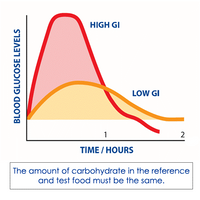Carbohydrates (carbs) are digested at different rates and this has an effect on your blood glucose (blood sugar) levels. The Glycaemic Index (GI) is a ranking from 1-100 and relates to how quickly these foods make your blood glucose levels rise after eating them.
What is GI?

Each time you eat or drink something sugary or starchy, the blood glucose level in your body rises. Some of these are quickly digested and cause quick and sharp rises in your blood glucose levels - they are called high GI foods and drinks. Low GI foods and drinks are more slowly digested and will make your blood glucose rise more slowly. These are sometimes called ‘slow release’ carbs.
Starchy and sugary food and drinks contain carbohydrates:
- Starchy foods such as bread, pasta, chapattis, potatoes, yam, noodles, rice and cereals.
- Fruit and fruit juice.
- Some dairy products such as milk and yogurts.
- Sugar and other sweet foods.
- Non-diet soft drinks
Foods with a high GI are not necessarily bad foods. For example, potato crisps have a medium GI but a baked potato has a high GI. Despite this, a baked potato is better for your health than potato crisps, which are higher in fat and salt. And all lower GI foods are not necessarily healthy – chocolate and ice cream have a low to medium GI rating. If you focus only on the GI of foods, you could end up eating a diet that’s high in fat and calories, making you more prone to weight gain and heart disease.
So, the key is to use GI in the context of balanced eating.
Why is GI important to me?
Most recommendations on eating a diet that includes a range of low GI foods are directed at people with diabetes, since this can help to control blood glucose levels. Research suggests that it’s the amount of carbohydrate you eat rather than its GI rating that has the greatest influence on your blood glucose level after a meal. Diabetes UK advises that people with diabetes eat sensible portion sizes of carbs and include low GI foods into everyday meals.
The GI value of a food is tested on the food when eaten on its own, and there are published lists of high, medium and low GI foods. However, it is not helpful to use the GI values in isolation, as we generally eat food in combination with other foods. GI needs to be taken in the context of varied balanced eating for it to be successfully incorporated into a healthy diet.
GI and balanced eating
Here are some everyday examples of lower GI carb choices.
- Multigrain, granary, rye, seeded bread, sourdough bread
- New potatoes in their skins, sweet potato, yam, cold boiled potatoes
- All pasta cooked until al dente, instant noodles
- Basmati rice, long grain or brown rice
- Bulgur wheat, barley, couscous, quinoa
- Porridge, muesli, some low-sugar oat and bran-based cereals
Many low GI foods are a good source of fibre or wholegrains. A healthy way to use the GI principles is to incorporate a range of lower GI carbs that are also rich in fibre and low in saturated fat.
For weight management, you also need to think about reducing your overall calorie intake by incorporating lower calorie foods into your meals and snacks. Consider the overall balance of your meals by looking at labels and choosing foods that are lower in saturated fat, salt and sugar, and keep an eye on your portion sizes.
GI and diabetes
There is good scientific evidence to suggest that basing your diet on low GI foods and keeping an eye on the total amount of carbs you eat, may help to control blood glucose levels for people with type 2 diabetes. Choosing low GI foods as part of a balanced diet can help to minimise fluctuations in blood glucose levels. In the long term this can help reduce the risk of complications of diabetes such as heart and kidney problems.
GI and weight management
There is some research to suggest that slow, steady rises and falls in glucose may help control appetite. Although many low GI foods are filling, there isn’t enough evidence to suggest that all low GI foods can help you to feel full.
10 Top Tips
- Carbohydrates come in different forms and some are healthier than others.
- ‘Slow release’ or low GI carbs have been shown to help stabilise blood glucose levels.
- GI can be helpful in diabetes because lower GI meals and snacks can help to keep blood glucose levels steady (which helps to reduce the risk of long-term complications of diabetes).
- The amount of carbohydrate you eat is more important than GI in diabetes.
- If you have diabetes and want to know more about how to use GI to help regulate your blood glucose, ask your GP to refer you to a dietitian.
- Lower GI foods can only help you to manage your weight if they are eaten as part of a calorie-controlled diet combined with regular physical activity.
- Lower GI foods like wholegrains, fruit, beans, lentils, and vegetables are generally lower in calories too.
- GI is about the physical make-up of a food and it is important to consider the mix of foods you eat, not just the GI value of the carbs.
- Some lower GI foods (such as chocolate cake) may be high in fat or calories and so they are not a healthy choice.
- In general, high fibre lower GI foods such as beans, peas, lentils, porridge, muesli, fruit and vegetables are good choices and can help you keep to an overall healthy eating plan.
For more information, take a look at our BDA Food Fact Sheet on Sugar.

